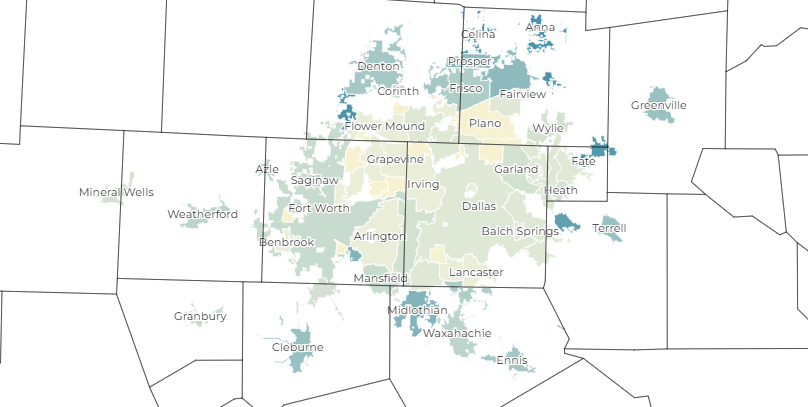Three Collin County cities top list of nation’s fastest-growing communities
Princeton was the fastest-growing overall while Fort Worth topped 1 million residents.
Dallas-Fort Worth boomtown Princeton is America’s fastest-growing city, and North Texas is home to five of the 15 fastest-growing cities in the country, according to newly released U.S. Census data.
Of cities and towns with a population of at least 20,000 people, Princeton topped the list with a 30.6% population increase between July 2023 and July 2024. The Collin County city’s population has more than doubled from roughly 17,000 in 2020 to an estimated 37,000.
We went from a small farming town to — I wouldn’t say the city level yet — but a lot of new faces, lots of traffic in a short period of time," said Princeton Mayor Eugene Escobar Jr. “We knew the growth was coming.”
Celina (18.2%) and Anna (14.6%) scored the fourth and fifth fastest growth rates in the nation. Melissa (10%) was another Collin County city that cracked the top 15. Collin County added the fourth most residents nationwide. Portions of Celina are located in Denton County.
Rockwall County’s Fate (11.4%) was the eighth fastest-growing city nationwide.
Texas cities claimed seven of the top 15 spots. Others outside of D-FW include Fulshear near Houston and Hutto near Austin.
North Texas fastest-growing cities for 2024
Three of the nation's five fastest-growing cities with a population over 20,000 are in North Texas. Princeton, which added 8,683 people between 2023 and 2024, was number one for the nation.

Suburban “ring” counties like Collin County are seeing new residents move there from Texas’ urban cores like Dallas. The small suburbs provide ready and available land for housing as the region expands, said Lloyd Potter, state demographer at the Texas Demographic Center.
It’s part of a larger pattern of growth in Collin County. First, it was Plano. Then it was Frisco. Now, it’s places like Princeton, Celina and Anna.
All three appeared on last year’s list with Celina at the top.
“These are the places where growth can occur,” he said. “Development is concentric in nature, so you see rings happening. As there’s less and less available housing … that kind of puts a lot of pressure on potential residents to look at those areas that are suburbs of suburbs.”
The growth extends beyond the region’s suburbs. Fort Worth added more than 23,400 residents, the fifth most in the U.S. The city’s population crossed the 1 million threshold, making it the nation’s 11th-largest city.
Other D-FW cities that added the most residents are McKinney (11,664), Dallas (8,924), Princeton (8,683) and Frisco (8,203). Dallas remains the nation’s ninth-largest city.
Based on county-level trends, Potter said Dallas has net out domestic migration but substantial international migration. Much of its growth comes from natural changes — more births than deaths.
Fastest-growing cities in the U.S., 2023-2024
North Texas is home to five of the 15 fastest-growing cities in the nation, according to new Census data. Princeton took the top spot.
| Rank | Cidade | Estado | População em 2024 | Variação Anual (%) |
|---|---|---|---|---|
| 1 | Princeton | TX | 37.019 | 30,6% |
| 2 | Fulshear | TX | 54.629 | 26,9% |
| 3 | Celina | TX | 43.317 | 26,6% |
| 4 | Anna | TX | 22.000 | 22,3% |
| 5 | Lathrop | CA | 35.000 | 16,9% |
| 6 | Centerton | AR | 20.000 | 13,6% |
| 7 | Haines City | FL | 28.000 | 11,2% |
| 8 | Georgetown | TX | 101.344 | 10,8% |
| 9 | Prosper | TX | 37.000 | 10,6% |
| 10 | Forney | TX | 30.000 | 10,5% |
| 11 | Kyle | TX | 52.000 | 10,4% |
| 12 | Lebanon | TN | 40.000 | 9,0% |
| 13 | Fort Mill | SC | 28.000 | 8,9% |
| 14 | Leesburg | FL | 25.000 | 8,8% |
| 15 | Athens | OH | 24.000 |
Collin County was also among the nation’s leaders in building new housing. Between 2023 and 2024, Collin County added nearly 18,000 housing units — the fifth most in the nation.
Other D-FW counties ranked highly on the national list. Both Denton and Tarrant counties added more than 13,000 units, and Dallas County added more than 9,700 housing units, according to the data.
Development is expected to continue in Kaufman and Collin counties. The areas are among the most active submarkets for newly built homes, according to data from Dallas-based market research firm Residential Strategies Inc.
Kaufman County led all D-FW submarkets with roughly 3,400 annual home starts through the end of March. Princeton ISD-Farmersville ranked second with nearly 3,350 annual starts. Celina was the fastest-growing submarket with more than 1,850 starts — up 55% year over year.
The city of Princeton is reckoning with its unprecedented growth. Princeton City Council voted last year to temporarily halt residential property development within the city and its extraterritorial jurisdiction. The pause remains in effect until July 2025 and could be extended again.
Homebuilders have worked around the moratorium. Developers who own land have opted out of the extraterritorial jurisdiction and formed special-purpose districts to fund key infrastructure for residential projects, said Ted Wilson, principal of Residential Strategies.
Advertisement
“I think they had so much growth that they were kind of overwhelmed by that,” he said. “We still see a lot of growth outside the city but in the Princeton ISD area.”
Princeton and nearby areas appeal to residents who work in Plano and Frisco but still want a home for under $400,000, Wilson said. The median home price in the Princeton ISD-Farmerville area was just over $344,000.
“If you’re looking at markets where you can go find an under $400,000 house, there’s limited selection out there,” he said. “That [U.S. Highway] 380 corridor certainly was the spot that we saw most of the growth for the last 10 years or so.”
Escobar said Princeton’s future growth was always talked about. Born in New York, he came to the area because his dad worked down here. He fell in love with North Texas.
He moved to McKinney in 2007 before ultimately settling in Princeton in 2013. The area was being marketed as “the next McKinney.”
Princeton has changed a lot since he arrived. Escobar was sworn in as the town’s mayor in late December. There’s good and bad that comes with being America’s fastest-growing city, he said.
“We’re going through those struggles. We’re going through infrastructure needs,” Escobar said. “But with the attention from it, we’re able to show what we’re building and how we’re able to manage the growth ... We’re trying to be more innovative. We kind of have a blank slate right now where people are watching us. Let’s show them how to build a city.”













